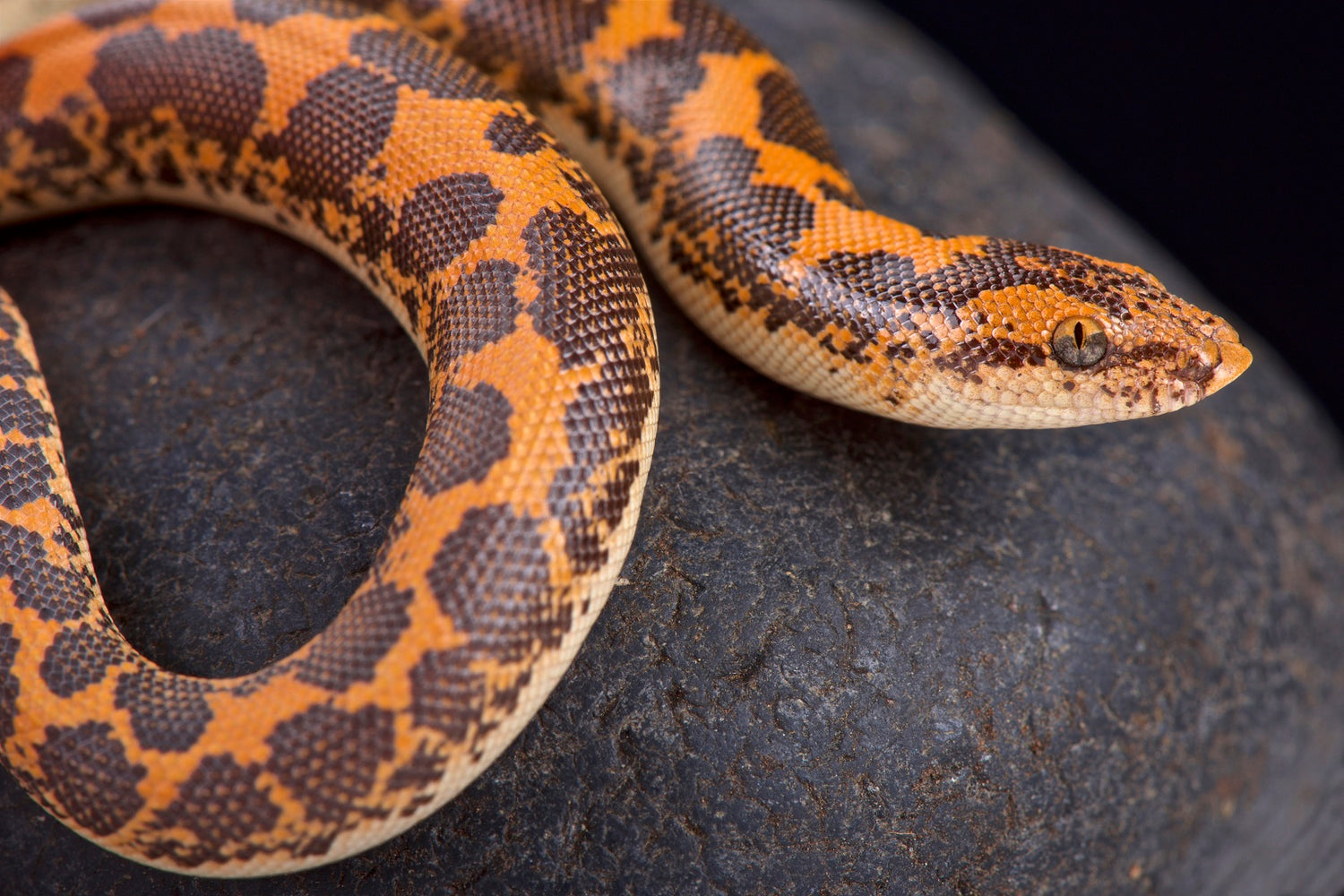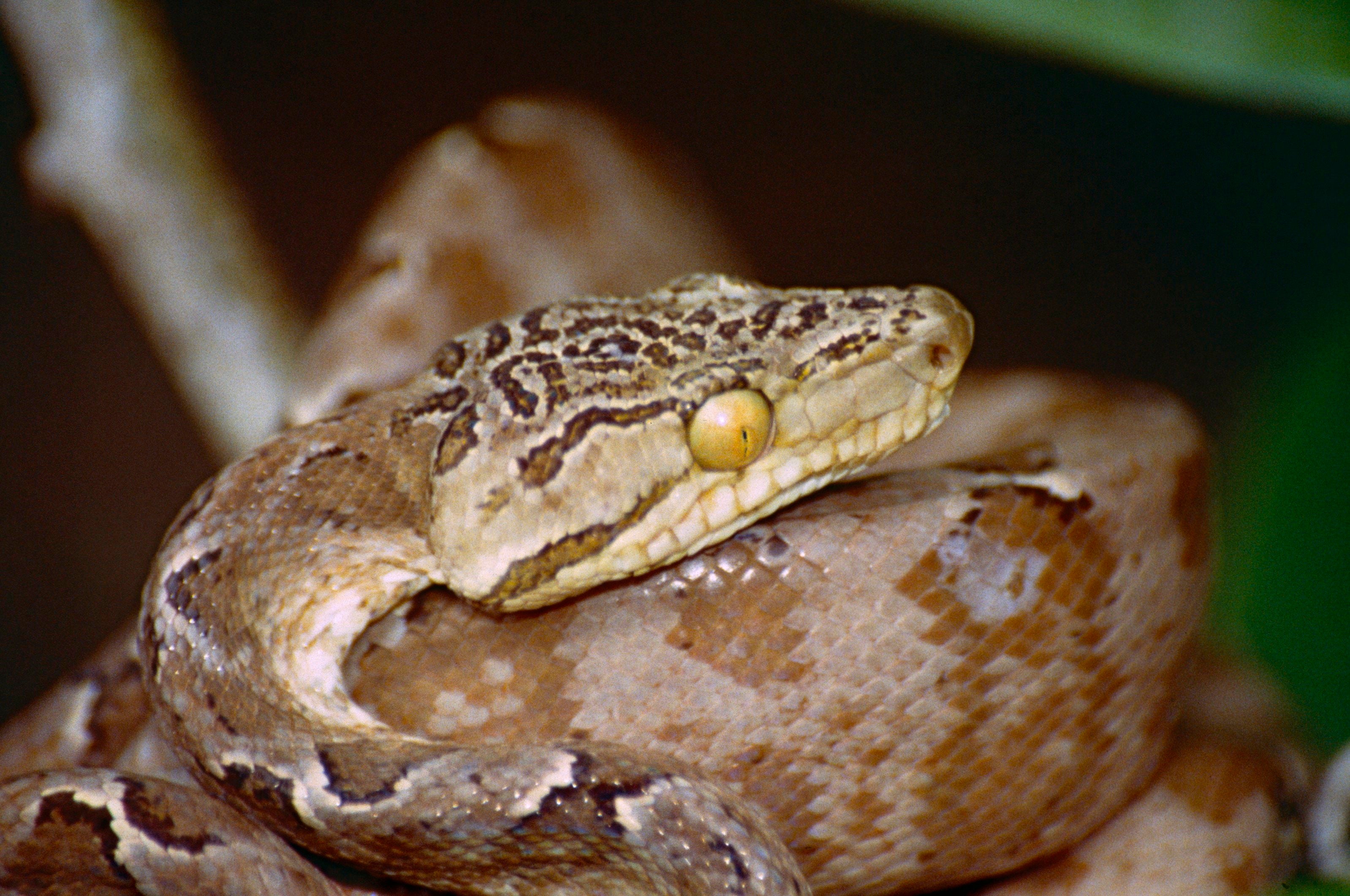Kenyan sand boas (Eryx colubrinus) are small, fossorial snakes native to northern and eastern Africa. Their preferred habitat is areas of loose, sandy soil with rock cover and low vegetation.
Kenyan sand boas typically grow to 18-36” long as adults, with males being significantly smaller than females. They have a thick, wormlike body with a blunt tail, small head, and eyes placed on top of the skull. Their scales are very smooth, except for the tail, which has larger, rougher scales. Wild-type Kenyan sand boas have a pattern of dark brown/black spots on an orange background, with a pale belly.
Kenyan sand boas are popular snakes for first-time reptile keepers because of their docile nature, slow movement, and ease of keeping. With good care, they can live up to 30 years.
How much space do Kenyan sand boas need?
Because of the significant difference in size between adult males and females, the minimum required enclosure size actually differs for each:
- Male — 30”L x 12”W x 12”H (20 gallon long)
- Female — 36”L x 18”W x 18”H (40 gallon breeder)
If you are unsure of your snake’s sex, err on the side of caution and use nothing smaller than a 36” x 18” x 18” enclosure. Juveniles can be housed in adult-sized enclosures, so there is no need to spend extra money on intermediary enclosures and their accessories.
Cohabitation (keeping multiple Kenyan sand boas in one enclosure) is not recommended, as like most snakes, sand boas are not a social species, and keeping them together is likely to cause more stress than benefit.
Do Kenyan sand boas need UVB?
They can survive without it, but it’s still best practice to provide UVB lighting for optimal health and wellbeing. UVB gives reptiles all of the vitamin D that their bodies need, stimulates better appetite and activity, and generally allows them to be healthier than they would be without.
Kenyan sand boas do best with low-strength UVB as part of their enclosure. The best UVB bulbs for Kenyan sand boas vary based on the size of the enclosure:
- 30” long, 12” tall — T8 Zoo Med Reptisun 10.0, 18”
- 36” long, 18” tall — T5 HO Arcadia 6%, 22” or T5 HO Zoo Med Reptisun 5.0, 22”
The UVB bulb should be housed in a reflective fixture and placed on the same side as the heat lamp. UVB is blocked by glass and plastic, so you can’t give your snake UVB by placing its terrarium in front of an open window. Also make sure that the fixture your UVB bulb is in does not have a clear plastic bulb cover.
Due to their equatorial origin, Kenyan sand boas should receive roughly 12 hours of light year-round.
What basking temperatures do Kenyan sand boas need?
Like other reptiles, Kenyan sand boas are ectotherms, which means that they need a temperature gradient in their enclosure to help them regulate their metabolism and stay healthy.
Kenyan sand boas should have a basking surface temperature of 95°F directly under a heat lamp placed to the extreme right or left of the enclosure. On the other side of the enclosure, the temperature should be between 72-80°F. Surface temperatures can be measured with an infrared thermometer, but air temperatures should be measured with a digital probe thermometer.
Provide heat for your Kenyan sand boa by imitating the sun with a halogen heat lamp placed on one side of the enclosure, positioned over the warm hide. Do not use ceramic heat emitters (CHEs), heat mats, red bulbs, or blue bulbs, as these are not as effective.
Heating should be turned off at night.
What humidity levels do Kenyan sand boas need?
Although Kenyan sand boas are often thought of as desert animals, they actually come from an area with moderate to high humidity levels. Average air humidity in your sand boa’s enclosure should be between 60-80%, as measured by a digital probe hygrometer placed in the middle of the enclosure.
There should be a 1-2” layer of moisture at the bottom of the substrate to offer your snake a humid retreat to use as needed. The easiest way to do this is to pour water directly into the substrate.
What substrate is good for Kenyan sand boas?
As a fossorial (burrowing) species, Kenyan sand boas require a thick layer of sandy substrate to dig around and hide in. As an added perk, it also tends to make the enclosure more attractive. We recommend the following substrates for Kenyan sand boas:
Substrate should be at least 4” (preferably 6”) deep and completely replaced every 3-4 months. Remove poop and urates daily, along with contaminated substrate.
What décor can you use in a Kenyan sand boa terrarium?
It’s terribly boring for a snake to be stuck in an enclosure with nothing in it except substrate and a water bowl. It doesn’t matter how big the enclosure is if you don’t put things in it for your pet to use and interact with.
Here are some decor ideas to help entertain your Kenyan sand boa:
What do Kenyan sand boas eat?
Like other snakes, Kenyan sand boas are carnivores, which means that they need to eat whole animal prey in order to get the nutrition that they need. Here is a basic feeding schedule based on snake weight:
- Babies — 1 pinky mouse every 5-7 days
- Juveniles — 1 fuzzy mouse every 1-2 weeks
- Adult males — 1 hopper mouse every 2-4 weeks
- Adult females — 1 small adult mouse every 2-4 weeks
- Large adult females — 1 medium adult mouse every 2-4 weeks
Prey items should be around 10% of your snake’s weight and roughly the same width. Although live prey can be used, it’s safest and most humane to use frozen instead. Prey should be thawed in a plastic bag in warm water to approximately 100°F before offering with a pair of soft-tipped tweezers. To prevent excess substrate ingestion, offer prey on a paper plate.
Young juveniles may refuse to eat pre-killed prey. If that is the case, you will need to use live until you can convert them to frozen-thawed.
Remember, the key to great nutrition is variety! Aside from offering mice, young rats and button quail can also be used to create nutritional variety in your Kenyan sand boa’s diet.
Supplements
Kenyan sand boas can survive without vitamin or mineral supplements, but occasionally using them can help prevent nutritional deficiencies and optimize your snake’s health. We recommend Repashy Calcium Plus LoD.
Water
Your Kenyan sand should have access to clean, fresh water at all times. Provide a water bowl large enough for the snake to soak its entire body if desired. Change the water daily and scrub the bowl with a reptile-safe disinfectant weekly, or whenever it becomes soiled.
Do Kenyan sand boas like to be handled?
Few reptiles actually “like” to be held, but Kenyan sand boas generally tolerate handling well. Be gentle, and pick up the snake from below rather than from above. Support as much of its body as possible, and NEVER pick up a snake by its tail!
*This care sheet contains only very basic information. Although it’s a good introduction, please do further research with high-quality sources to obtain additional information on caring for this species.




Leave a comment
This site is protected by hCaptcha and the hCaptcha Privacy Policy and Terms of Service apply.